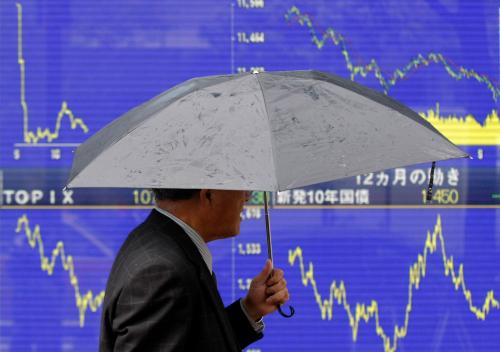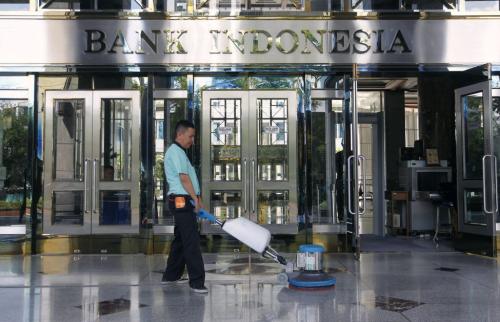This week, Governor Zhou of the People’s Bank of China warned of the risks of a “Minsky moment” in China. This highly technical term was read for what it was—an extraordinarily strong warning from a sitting central bank governor. It refers to a phenomenon, documented by the celebrated United States economist Hyman Minsky, where over-optimism on the part of borrowers and lenders can lead to poor quality and rapid credit growth and inflated asset values, followed by a sharp financial correction and crisis. The global financial crisis is a prominent recent example of a Minsky moment.
When the governor of the largest economy in the region is making these kinds of comments, it is worth reflecting on the region’s risk preparedness—even more pertinent on the 20th anniversary of the Asian financial crisis.
East Asian preparedness since the Asian financial crisis
East Asia is still delivering a significant share of global economic growth. This is by no accident—the region has worked hard to improve its macroeconomic and financial fundamentals over the last 20 years. Another crisis is not imminent or inevitable, but as Minsky, and now Zhou, warned, this is exactly the time to focus on crisis prevention and preparedness.
Indeed, there are obvious risks to be alerted to that could put stress on the region. The most important one relates to how the Chinese credit boom is resolved, which will affect all other economies in the region given its strong trade and investment interconnections. Protectionist actions by the U.S. or others could strongly affect the region given its reliance on trade. And there will be continued risks of a return of volatile capital flows, hidden vulnerabilities, and policy mistakes.
The region is better prepared to manage another crisis than it was 20 years ago. It is well represented on the G-20 and Financial Stability Board, two bodies that will be critical in coordinating any crisis. It is increasingly well represented at the International Monetary Fund.
East Asia also has access, at least on paper, to significant crisis-fighting resources through the IMF, Association of Southeast Asian Nations Plus Three’s (ASEAN+3) own foreign exchange swap arrangements (known as the Chiang Mai Initiative Multilateralization or CMIM), and bilateral swaps between countries in the region.
By some calculations, these resources total around three-quarters of a trillion dollars. This needs to be kept in context though: The international rescue package for the countries involved in the Asian financial crisis would be over $300 billion in today’s dollars, taking into account the growth of these economies.
Furthermore, there are gaps in crisis response mechanisms that could mean many of these crisis-fighting resources are not deployed, which could leave the region bearing too high a cost if that “Minsky moment” was to arrive.
How would East Asia respond to another financial crisis?
Imagine the following scenario sometime in the next few years. A large ASEAN economy is running into difficulty due to a demand shock from China and volatile capital flows, and talk of “another Asian financial crisis” is contributing to signs of a run on some of its financial institutions. With bad memories from the Asian financial crisis, the country hesitates to call the IMF for assistance. There are doubts about whether the CMIM will be triggered. Instead, the country is calling China, Japan, and Australia seeking bilateral assistance.
These countries would all face a very difficult set of choices. Should they provide support without the umbrella of an IMF program? How will they cooperate in a response? Will the response be fast enough and sizable enough to stop a panic? How will they manage their own macroeconomic challenges, which are almost certainly flowing from these events, while being part of a regional response?
East Asia should seek to reduce the chances of such a situation and improve the range of policy options available. There are five key elements of a strategy to mitigate regional economic risk.
First, the region should use its membership in international organizations to concertedly manage regional risks. It should draw on its networks to ensure strong messages are sent on the need to address emerging risks. If a crisis were to emerge in the region, it would have global impacts. The regional members would need to work together to ensure the G-20 effectively fulfills its crisis coordination role.
Second, the IMF needs to be an early rather than last resort. With risks building in core economies, the region needs access to global resources, not just its own. The region should support development of, and then take up, precautionary lending instruments that can increase the speed of deployment of IMF and CMIM resources.
Third, the region needs to work to ensure the IMF lending capacity remains strong against medium-term real risks. Risks are posed by the fact that several loan arrangements to the IMF expire just after 2020, and it will be difficult to secure the support of the major shareholders for either their continuance or an increase in quota resources.
Fourth, CMIM members should ensure this mechanism is fully operational, including closing the technical and coordination gaps revealed in recent “test runs” undertaken with the IMF. While the IMF will be needed in most significant crisis events for the foreseeable future, the region needs well-functioning arrangements, including as a hedge against IMF resources contracting over the medium-term.
Fifth, the major potential bilateral donors should work together in “peace time” to ensure a coordinated response in a crisis. For a range of crisis scenarios, bilateral swaps and other lines of credit may well be the “first responders.” It is important donor countries take a consistent approach to crisis resolution.
Going forward
Crises in the region are not inevitable but neither are they unlikely. And as Minsky pointed out, and recent history attests, crises can emerge at the end of a run of growth. Determined efforts to close gaps in current arrangements would give the region greater confidence in achieving better outcomes. This could contribute to the resilience of the region and, ultimately, the global economy.
This is drawn from a Working Paper: Risk and Resilience in East Asia. Barry Sterland is a Visiting Fellow at the Brookings Institution, and represented Australia and other largely Asia-Pacific countries as Executive Director on the IMF Board between 2014 and 2016. He is on secondment from the Australian Treasury, though the views expressed here are his own.
The Brookings Institution is committed to quality, independence, and impact.
We are supported by a diverse array of funders. In line with our values and policies, each Brookings publication represents the sole views of its author(s).




Commentary
Avoiding another economic crisis in East Asia
October 25, 2017